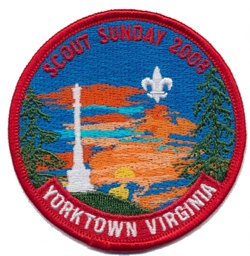
According to the Blue Book Standard Order of the Arrow Insignia Catalog there are three varieties of the Kecoughtan Lodge S1 flap patch, first issued in 1953. All share the same design, have a cut (rather than rolled) edge, but have subtle differences which distinguish them.
The S1a variety is listed with the following comments in the Blue Book:
BLK BMT; FF; WHT back; coarse bkgd stitch; (1953) - which translates to "black base material, first flap, white back, coarse background stitch, first issued in 1953"
The S1b variety is listed with the following comments:
predominately BLK on back; BLK BMT; fine bkgd stitch; FF - which translates to "predominately black on back, black base material, fine background stitch, first flap"
The S1c variety is listed with a single comment:
GRY BMT - which translates to "Gray base material"
I am fortunate to have a 463s1a flap patch in my Kecoughtan Lodge patch collection, but would like to add an S1b and S1c to have all of the different varieties. Unfortunately this is not an inexpensive item to acquire. Two Kecoughtan S1 have recently been listed on eBay, with prices in the neighborhood of $500 each.
Last week a 463S1b was listed for auction with a photo of the front of the patch, and I found myself frustrated in my attempts to determine if the patch was indeed the second variety. It's hard to determine if the patch you are looking at has coarse or fine stitching, and even more difficult to determine the color of the base material without seeing the back of the patch. To really ensure accuracy you need to have samples of each variety in hand to identify and contrast the differences and compare each with the patch in question to make a proper identification.
Not having that luxury, I sought the opinion of fellow Scouter Larry Johnson who is also an avid collector of Kecoughtan Lodge emblems as a former member of that Lodge before it merged with Chanco 483 in January of 1996 to form Wahunsenakah Lodge 333. Since his collection contained examples of each 463s1 variety he quickly scanned both the front and the back of each and emailed me the pictures.
Meanwhile the seller had kindly responded to my request for a picture of the reverse of his patch. Using that and Larry's pictures I was able to quickly determine that the patch was actually an S1c based upon gray base material. By the time I sent my feedback to the seller he had already discontinued the auction due to the listing error.
Since Larry's pictures were invaluable to me in identifying the differences between the Kecoughtan 463 first flap varieties I decided to create a comparison picture to help others that might benefit from this resource. All credit goes to Larry for the excellent pictures and to the original contributors of the Blue Book who originally identified the variations, cataloged, and submitted them for publication






